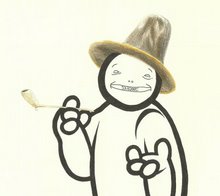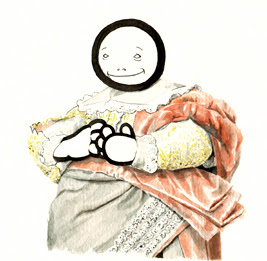
5.12.07
24.10.07
✪ Reprap the home-made 3-d printer.
More on rapid prototyping in this article I wrote earlier.
This is the result so far with our Reprap 3-d printer at [foAm] (Pics).
You may notice that it even has some wooden parts!
Before this I went to the fablab that is set up in Mediamatic. Here's some images from the workshop there:

Posted by
theun
0
comments
![]()
Labels: 3d printing, fabbing, model, rapid prototying, stone
11.10.07
✪ Swiss army bunker-chalets.

Ojode Pez a wonderful documentary-photography magazine, recently featured a collection of photographs of some strange architecture, taken by Christian Schwager.
Certainly this highlight from the history of military architecture deserves a closer look, for some of its features can be found in more recent large scale housing-projects and mass-urban-planning, where homes can look as fake as these bunkers do.
What looks warm and comfortable from afar, becomes chilling and lifeless under closer inspection.

And some more can be found on flickr:

Posted by
theun
1 comments
![]()
Labels: architecture, bunker, Ojode Pez, Schwager
3.10.07
✪ Satellite sees CME tear comet tail off.
NASA's STEREO satellite captured the first images ever of a collision between a coronal mass ejection (CME), and a comet. The collision caused the complete detachment of the comet's plasma tail.
Posted by
theun
0
comments
![]()
2.10.07
✪ The dignity that comes with manual labor.


For a hundred years the villiage of Oeschberg near Bern has featured an old-folks-home for Knechte und Mägde: farmhands and maids, who served on farms all their lives. Now they are spending their latter years working for themselves at the home. Photographer Andreas Reeg made some impressive pictures of them.



I don't want to romanticize old-fashioned ways of living, but obviously any snotty little rapper driving his tribal tattoos around in some pimped-up Hummer, will in his hart of harts know that these people have a dignity and strength of character that he will never have.
And crafts are technology too!!!
Posted by
theun
0
comments
![]()
Labels: crafts, farming, photography, reeg
5.9.07
✪ Tomytronic, gaming technology from 1980.
In case you're wondering if in the future there will ever be a handheld game with 3-D visuals and 3-D sound, you will be surprised to hear that this game of the future has already been made, in the early eighties.

This is the  handheld game. Really wonderful to play, and an experience beyond anything that that your playstation can throw up.
handheld game. Really wonderful to play, and an experience beyond anything that that your playstation can throw up.



✪Shark Attack ✪Planet Zeon ✪Skyattack
The best of all is the 1983 Skyfighters game, when your airplane flies out-off the left side of the picture, and the sound passes behind your head, all-around, until the plane shows-up again on the right of the screen. Now that is what I call VR.
More on Tomy in the handheldmuseum.
Posted by
theun
0
comments
![]()
✪ The fabbing revolution is coming.

When the prehistoric world was introduced to ceramic technology, it really knocked people over. Until that time they had to fashion their tools by crudely or delicately knocking stones together and using the different types of flint that this produced.
But then ceramics hit the scene.
With pottery however you could simply mold any shape you liked and color could be added.. it was just unbelievable. To us these objects may look simple, to these people it was magic.
A similar revolution may hit society today:
Personal Fabrication
It enables you to create any new technology or gadget you may wish to build. A 3-D printer can help you to manufacture anything that mayor companies like Philips, Sony or Apple can build. Let's hope this liberates todays passive consumers, to become active participators and inventors.
The possibilities are amazing, just take a look at the printer and these printed models (the curly one is made of sugar):


The fabbing printer was created by Neil Gershenfeld, who likens its development to that of the first personal computers.
(klik his portrait for an video interview.)
Neil Gershenfeld
for more on fabbing check out: foam and waag websites.
Posted by
theun
0
comments
![]()
Labels: 3d printing, fabbing, model, rapid prototying, stone
22.8.07
✪ Pala Di San Martino

This mountain range can be found in the Dolomites. Part of it is known as Pala di San Martino, or the Balls of Saint Martin. It is possible to walk and climb around these Holy testicles and when you do so it takes you into the strange landscape of lifeless rock-formations.
A curious effect of the barren stone landscape is that it is very difficult to asses its scale. The only thing you can estimate about the size of your surroundings is that it lies between certain limits that depend upon common sense. But with little effort these giant rocks can even be imagined to be the size of a pebble.
It is only when people or chalets appear in the landscape that its true scale becomes apparent.
This effect can be found in reverse order in the Suiseki or Penjing stones of Japan and China. These objects were used to let the mind wander through a landscape that fits on your desk.
Klik on the picture for a previous post on those stones:
Alton Delong has done very interesting work on scale and human perception.
When he asked people to play Pong on a 7-inch and a 23-inch screen he found that the size reduction considerably improved concentration in players.
When he created three model waiting-rooms he discovered that scale reduction compresses the perceived time of people.
- At scale 1/6 : 30 min becomes 5.43 min on average.
- At scale 1/12: 30 min becomes 2.66 min on average.
- At scale 1/24: 30 min becomes 1.49 min on average.
Delong has also worked on class-room designs.

I came across his work and the Penjing stones in a stunning book by Douglass W. Bailey called Prehistoric Figurines; Representation and corporeality in the Neolithic.
29.7.07
✪ Eertclootschrift.

Stevin, die eerst der zeeën vloed
En ’s aerdrijks omzwaei heeft bevroed
Some wonderful expressions used by Simon Stevin in his Wisconstige Gedachtenissen.
Eertclootschrift: geography
Eertclootschrijvers: geographers
Dwaeler: planet
Dwaelerloopen: orbits
Stofroersel: material sciences
Stofscheyders: alchemists
Spieghelaer: theoretician
tuychwercklick: mechanical
Sichteinder: horizon
Hemelloop: astronomy
Deursichtighe: optics
Gaslagher: observer
Lycksydicheyt: symmetry
Posted by
theun
1 comments
![]()
Labels: Stevin
28.7.07
✪ Suiseki or Penjing stones.
A collection of Suiseki or Penjing stones.
Suiseki are traditional Japanese viewing stones they also appear in China as tray-sized landscapes: Penjing which have a long tradition in Chinese scholarly art, dating from the Qin an Han Dynasties.
It's four aesthetic concepts:
- gugao or aloofness
- jianjie or sparseness
- ya or refined elegance
- pingdan or plainness















Posted by
theun
0
comments
![]()
Labels: landscape, model, penjing, scale, scholarstone, stone, suiseki, virtual reality




